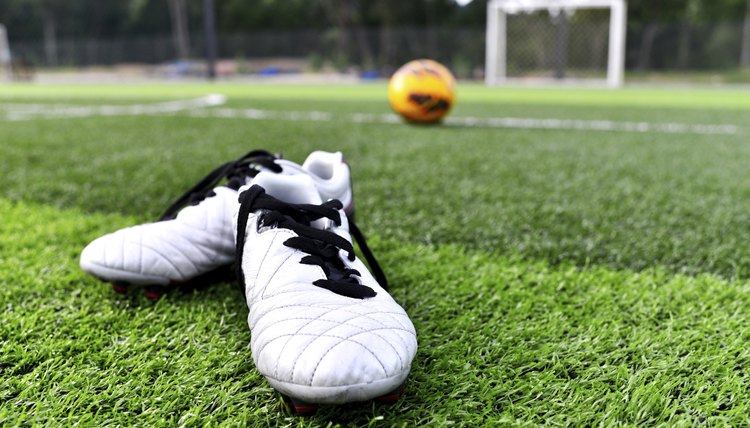Regulations for Soccer Cleats

Soccer cleats are worn by players to help them gain traction on various playing surfaces, including grass, sand and clay. Like most soccer equipment, the cleats must conform to several regulations. These regulations are instituted to maintain a safe playing environment for all players.
General Regulations
In general, the same rules apply to soccer cleat use across different leagues at the national and international level. FIFA's rule book specifies only that adequate footwear is worn. According to the NCAA, “Shoes with soles containing aluminum, leather, rubber, nylon or plastic cleats, studs or bars, whether molded as part of the sole or detachable, are allowed.” In practice, any cleat that is specifically made for soccer is allowed, even those with detachable, metal studs.
Front Cleat
One area that can lead to confusion is the presence of a front stud, positioned at the very tip of the bottom of the cleat. This type of stud often is found on baseball, football and lacrosse cleats because it helps players gain more traction on the field. However, in soccer, such stud placement is dangerous. As players attempt to take the ball from one another, a front cleat is in a prime position to cause injury to the feet, shins and knees of other players. As such, any cleat with a front stud usually is outlawed.
Local Leagues
While most soccer leagues follow the same rules, there are exceptions. Any league is allowed to make changes to the regulations on player equipment. Referee Tom Stagliano points out one such example: “In Massachusetts, soccer cleats with any metal (even metal tipped) currently are illegal.” To be safe, before you purchase a new set of cleats, check for any specific rules set by your local league. If you can't find an answer, consider molded plastic cleats to be the safest choice.
Considerations
While soccer regulations for cleats may seem lax, there is a catch. If the referee believes your cleats to be dangerous for any reason, he can prohibit you from playing. Referees are particularly cautious when they see metal cleats. Over time, metal cleats can wear down from walking on hard surfaces and become sharp. If you prefer metal cleats, make sure to wear them only on soft surfaces. To be safe, also consider purchasing a backup set of cleats made from molded plastic.
References
Writer Bio
Patrick Hutchison has been doing freelance work since 2008. He has worked as a physical therapy aide and as a writer for various websites including Destination Guides and several travel-related companies. Hutchison has a Bachelor of Arts in history and anthropology from the University of Washington.
